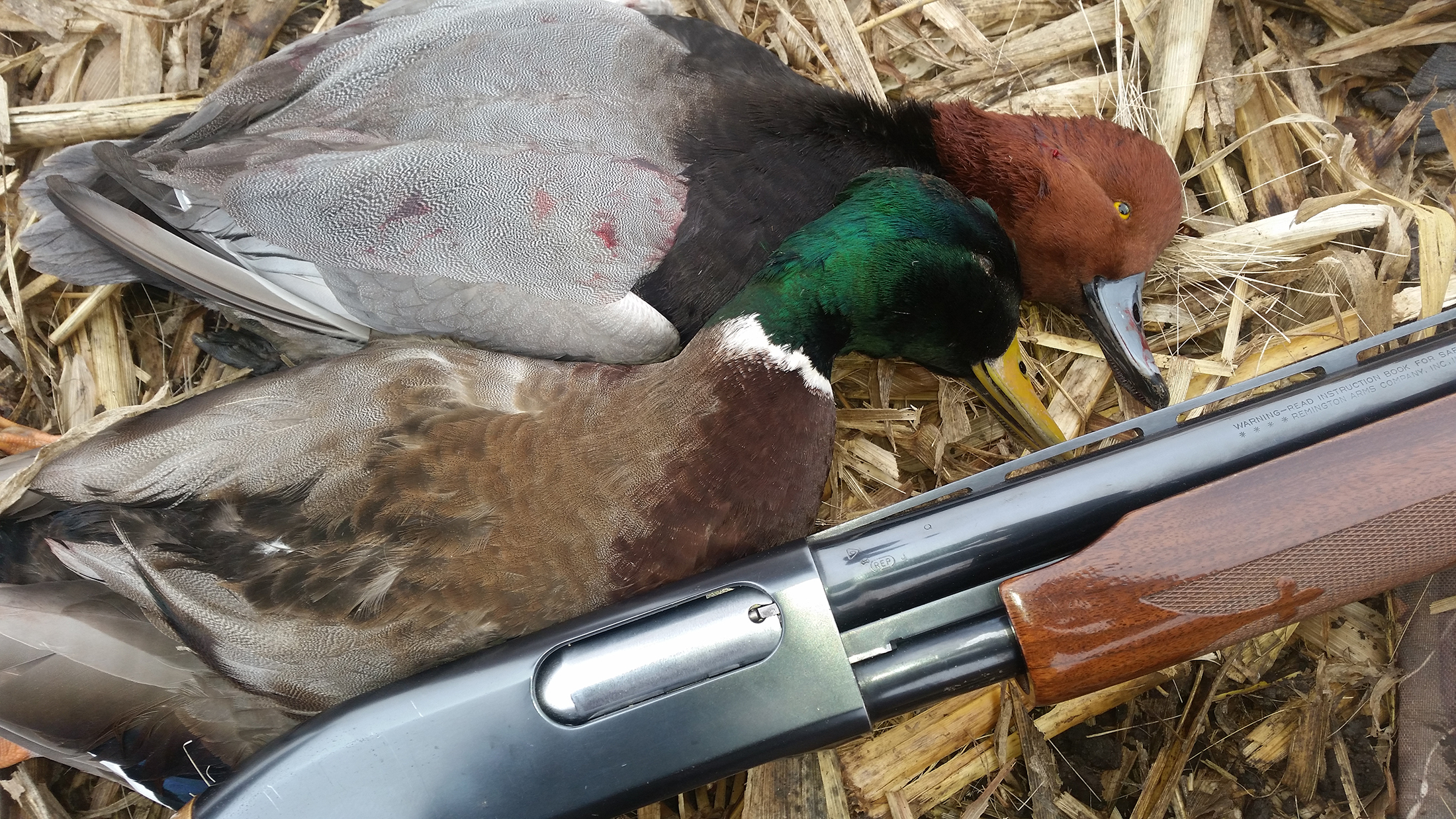A friend summed up the Remington 870 perfectly, once as we argued about which was the greatest shotgun ever made. The 870 was the greatest, he said, because it was the best possible gun that the most possible people could afford. He wasn’t wrong. The 870 is a gun for the masses. It stands as an example of mass-produced, affordable excellence, and it has for 75 years.
There are literally millions of 870s still on the job. With more than 11,000,000 made and (hopefully) counting, Remington’s famous pump has been used to hunt anything you can hunt with a shotgun. It has won countless clay target events. It has served in war, in law enforcement, and as a home-defense shotgun.
Designed to be made with methods developed for rushing arms to the troops during WWII, the 870 was a great, inexpensive gun ——not a cheap one. Its introduction in 1950 marked a new era of firearms manufacture.
See It
- Action: Pump
- Produced: 1950-present
- Designer: Remington design team: L. Ray Crittendon, Phillip Haskell, Ellis Hailston, and G. E. Pinckney
- Gauges: 12, 16, 20, 28 and .410
- Notable Variants: Wingmaster, Upland Special, 3 ½-inch SPS Super Magnum, Trap and Skeet Grades A,B and C, Express
Remington 870 History

In the late 40s, Remington set out to make a pump gun that could compete with the Winchester Model 12. Before the 870, the Winchester Model 12 was the king of pump-action shotguns. Introduced in 1912, it was slick, reliable, and it pointed beautifully. It was also very complicated, and expensive to build. The Model 12 was all steel, with machined, hand-fitted parts. Remington’s pre-870 pump, the Model 31, was also an excellent gun, and, like the Model 12, it was expensive to make. Although it had its fans, the 31 never enjoyed the popularity of its Winchester rival.
Unable to beat the Model 12 head-to-head, Remington decided to undercut it in price by making a new pump gun that would be less expensive to build. Actually, they went even further: the design team conceived of a “family” of guns that would reduce costs by sharing some common parts. Four guns would eventually make up the family: the 11-48 semiauto shotgun, the 870 pump, the 760 pump-action rifle and the 740 semiauto rifle. The 11-48 came first, in 1948. The 870 followed in 1950, making use of 60 11-48 parts, including the receiver. In addition to common parts, the 870 made use of stamped metal and alloy parts where possible, and the gun required much less machining than the Model 31. A Model 31 required 586 separate machining operations, while the 870 only needed about 150.
But there was more to the 870 than cost-cutting measures. The 12-gauge 870 actually used a 16-gauge 11-48 receiver, which contributed to the finished gun being trim and light. The forearm had twin action bars linking it to the bolt, helping to prevent twisting and binding when you cycled the gun. The stock had enough drop and a thin-enough comb that it fit a wide variety of builds and faces. The 870 was a gun almost anyone could shoot.
It came in 12-, 16- and 20-gauge from the start. The 12s, with their slender receiver and ribless barrel (they weighed under 7 pounds), were ideal for upland hunting. Originally the 12-gauges came with a ¾-pound “Vari-Weight” steel magazine plug that you could use to add weight for waterfowling or target shooting.
From the outset, the 870 sold for less than the Model 12. In 1950, it listed for $15 less, which is the equivalent of $200 or so today. It helped, too, that the 870 was lighter and more modern than the 38-year-old Model 12. It was easier to take apart. There were no screws, only pins to push out, and it had a threaded magazine cap that allowed easy swapping of barrels. Better yet, those barrels didn’t require fitting so you could own more than one barrel, making your gun versatile.
Out of the box, the 870 shucked smoothly, too. Trapshooter Rudy Etchen gave the new gun a huge P.R. boost by taking one of the very first 870s to roll off the line and using it to become the first person to break 100 straight trap doubles targets with a pump gun at the 1950 Grand American Handicap. The new gun was an immediate success.
Glory Days
For many years the 870 Wingmaster ruled the pump gun market. The 3-inch 12-gauge debuted in 1955, and the 3-inch 20-gauge followed in 1960. The 870 would be made in every gauge except 10-gauge, and for every purpose. It was made into deer guns, trap and skeet guns, military and LE guns, and, in the 1980s, short-barreled, straight-stocked upland guns.
Remington made the one-millionth 870 in 1966. The mid-60s also saw the first 870s to be decorated in what I think of as the “classic” 870 style, with the walnut furniture finished in a high-gloss urethane with pressed fleur-de-lis style checkering. The blue and polished metal on these guns was immaculate, too. Whether you liked that look or not, there is no denying that the guns from that era were beautifully made and finished.
In 1971, the left-handed 870, a true mirror-image, became the first left-handed pump ever made. The two-millionth 870 was made in 1973 and by 1978 Remington hit the three-million mark.

The 1980s saw big changes in the 870. The guns got a makeover, with satin-walnut stocks and cut checkering, as well as RemChoke choke tubes in 1986. In 1987, the 870 Express was introduced as a lower-priced entry-level gun. It had a hardwood stock, bead-blasted metal finish, and the interior parts, while identical to the Wingmaster’s parts, were not as thoroughly polished. It would become a huge success for Remington. It was also a backhanded compliment to the Mossberg 500, which could undercut the 870 the way the 870 had undercut the Model 12. The Express was Remington’s way of competing with the Model 500.
In the 1990s the 870 hit the six- and seven-million marks. In 1998, the first 870s chambered for the 3 ½-inch 12-gauge hit the market.
21st Century Woes
Despite the success of the 870 – millions more would be made – the early 2000s saw Remington in financial trouble. The company would eventually sell to Cerberus, a private equity group in 2007, and Remington was made part of the “Freedom Group” that included Marlin, Bushmaster, and several other companies. Under new management, 870 quality slipped badly, especially among the Express models. Aging machinery, poor quality control, and cost-cutting measures turned the once ultra-reliable 870 into an often-balky gun. The problems with 870s usually centered around rough, poorly finished chambers that caused hulls to stick in the gun instead of extracting smoothly after firing.
Remington still made lots of good 870s during that time. My SPS Super Magnum turkey gun, a 2008-vintage gun, has been a rock-solid gobbler-getter for me. On the other hand, I visited the Ilion, New York factory in the late 2000s and came home with a left-handed 870 Express that had so many problems I eventually stripped off any potentially useful parts and took the remains to the landfill.
My 3 ½-inch Express waterfowl gun is the exception that proves the rule that Express 870s of the era had problems. It cycles everything perfectly, but only because I took it to my gunsmith and asked him to polish the chamber. He was so tired of honing 870 chambers that instead he sent it to Remington and said “fix it.” They did. I had it cerakoted, and turned it into a bulletproof waterfowl gun and the only reason I don’t have it today is because my younger son decided that he needed it more than I did.
Remington eventually went bankrupt. As the Freedom Group properties were broken up and sold off, the RoundHill investment group bought Remington. RoundHill changed the name to RemArms, since VistaOutdoor, parent company of Federal, bought the ammunition business and the Remington name.

The new ownership also introduced their new 870 Fieldmaster. The first 870 Fieldmasters made under the new ownership were put together from parts in inventory, but inspected rigorously. The ones I have shot worked the way 870s are supposed to work. Currently the 870 is stuck in transition as manufacturing is moved out of the historic, but aging and over-sized factory in Ilion, New York, to a new plant in Georgia.
You can buy the synthetic version of the new 870 Fieldmaster, but as I write this the wood-stocked versions seem to be sold out almost everywhere. When the new facility is fully up and running, we can only hope it’s the start of the 870’s next 75 years.
A RemArms representative told OL this spring that “our new facility is not up yet but planned to be by the end of the year.”
Read Next: Remington 870 Fieldmaster Review: Torture Testing the Shotgun That Will Replace the Express
Notable Variants

The 870 has been made for every possible purpose over its long life. Just about any 870 made from 1950-2000 is worth grabbing on the used market, and some of the 21st century guns are okay, too. Among the models to watch for are the Upland Specials, made in the 1980s. With short barrels, straight grips and a satin-finished, checkered wood, they still make a great upland gun today. They wouldn’t do badly in the turkey woods, either, if you can find one of the later models with interchangeable choke tubes.
The trap and skeet models came in three grades: T (or S for “skeet”) A, B, and C. The B-grade guns had a higher grade of wood and impressed checkering. The C-grade guns had high-grade wood and cut checkering. The B grades especially are a good buy. The 870 Competition was a unique target gun made for a few years in the 80s. It was a single-shot pump with a gas system borrowed from the 1100 semiauto to reduce recoil, and it worked beautifully, although the only two I am personally aware of both suffered split forends, which may be a coincidence or it may not, and good luck finding 870 Competition wood.
Virtually any 870 Wingmaster with fleur-de-lis checkering is likely to be a good one, and people snap them up these days. Earlier guns had 2 ¾- or 3-inch barrels and receivers, so if you want to shoot 3-inch shells look for “Magnum” on the receiver. The SPS “Special Purpose” guns were made in waterfowl and turkey models, and they feature matte or camo finishes but are built to standards higher than the Express guns.
Tips on Owning an 870

The first tip on 870 ownership is that you should own one, maybe more than one. There are 870s to avoid, however. One is the 16-gauge. It was built on a 12-gauge frame, so it weighs as much or a bit more than a 12, which all but defeats the purpose of the gun.
Among the worst of the early-2000 Express guns were the ones that came with a little sheet-metal key and a locking safety button. It’s not that the buttons were bad, it’s that the guns of that time were awful. Likewise steer clear of the Expresses with laminated stocks. They were bad guns with cheap stocks. Those safeties and stocks are red flags.
There are plenty good, older 2 ¾-inch 870s. You can either buy them and shoot 2 ¾-inch shells or you can have a gunsmith reposition the extractor (which requires rebluing the receiver), and lengthen the chamber. Or, hold out for a gun with “Magnum” engraved on the receiver before you buy.
The 870 trap guns kick, so shoot lighter loads out of them. The 870 safeties are not reversible for left-handed shooters. You’ll need a new part. The bead-blasted finish on the Express models rusts easily. Be sure to wipe your gun down, and don’t store it closed up in an unbreathable case throughout the off-season or it might be orange when you take it out again in the fall.
For whatever reason, when you reassemble your 870, you’ll find the 12-gauge shell latches pop right in, while the 20-gauge and smaller latches are a pain until you learn the trick. I haven’t learned the trick yet.
There are a bunch of great aftermarket parts for 870s. The Timney Trigger Fix is expensive at $100, but it’s great if you’re picky about triggers. Volquartsen makes a nice, machined extractor claw that replaces the cheap M-I-M part in many 870s. Likewise you can get an aluminum magazine spring follower to replace the factory part for more reliable feeding. You can find plenty of aftermarket stocks and other accessories as well.
Read Next: Best Pump Shotguns
Final Thoughts on the Remington 870

Regardless of what happens to the 870 as production moves from New York to Georgia, the 870’s impact on gunmaking history, its reputation, and its status as a genuine smoothbore icon are secure. There are very few gun cabinets in the United States that don’t contain at least one 870, which means millions of people own what I might actually have to admit, is, indeed, the greatest shotgun ever made.
Read the full article here





![CNN Anchor Struggles to Understand Why Immigration Laws Are Enforced [WATCH] CNN Anchor Struggles to Understand Why Immigration Laws Are Enforced [WATCH]](https://www.lifezette.com/wp-content/uploads/2025/08/2025.08.07-08.12-lifezette-68945ff06113f.jpg)





![Sec. Kristi Noem Accuses ‘Democrats of Running a Shadow Government Through a Maze of NGOs’ [WATCH] Sec. Kristi Noem Accuses ‘Democrats of Running a Shadow Government Through a Maze of NGOs’ [WATCH]](https://www.rvmnews.com/wp-content/uploads/2025/09/2025.09.06-11.24-rvmnews-68bc19ffbb103.jpg)
